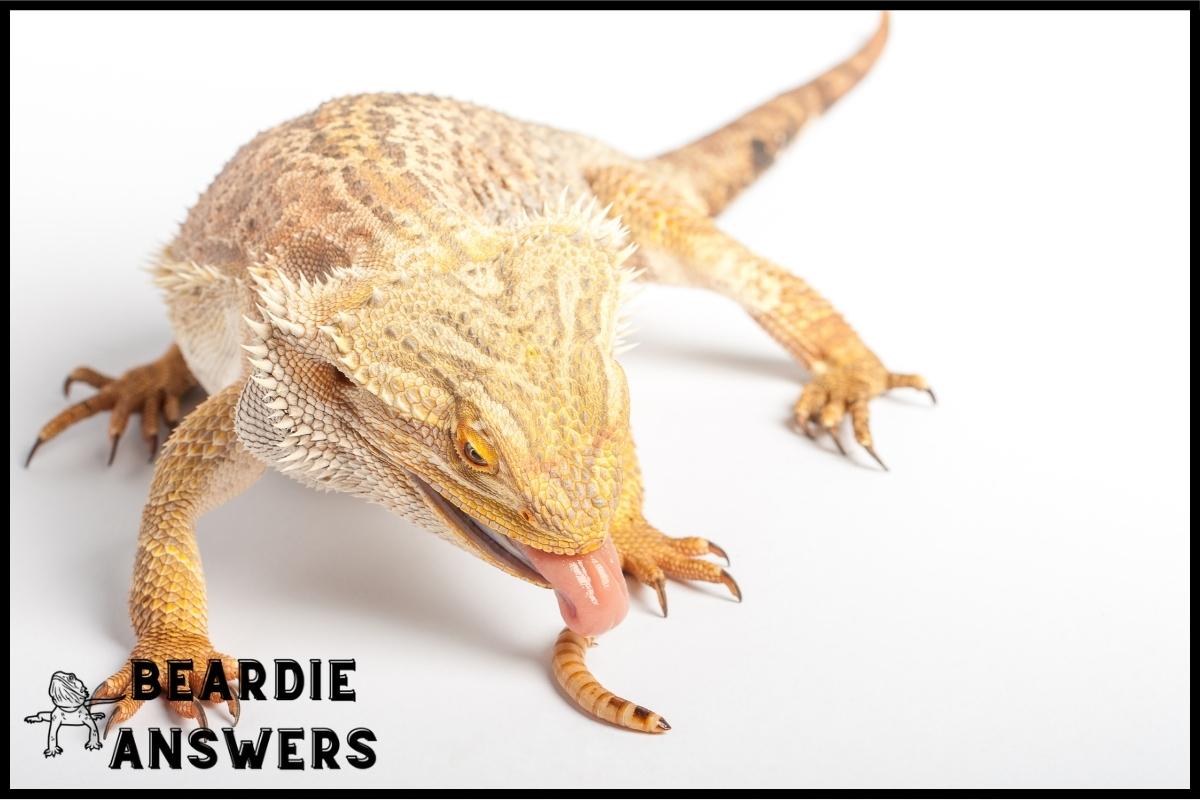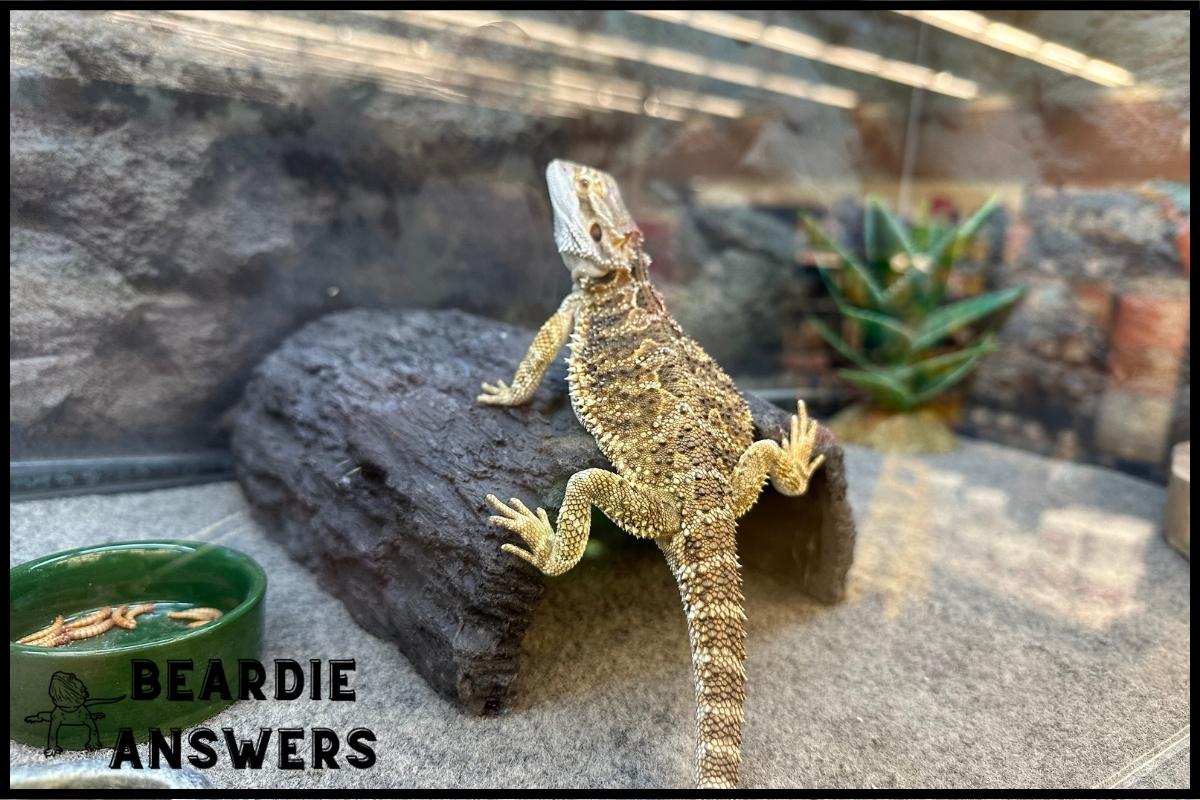Bearded dragon poop is typically brown, solid, and elongated. The consistency and color of their poop can vary depending on their diet, hydration levels, and overall health. It’s important to monitor your pet’s poop regularly as changes in color or consistency could be a sign of underlying health issues.
What You'll Learn
The Basics Of Bearded Dragon Poop
Bearded dragon poop is an important part of their health and should be monitored closely.
The type of food they eat, as well as the cleanliness of their substrate, can give us insight into what normal bearded dragon poop looks like.
They are omnivores by nature which means that their diet consists of both plant matter and insects.
This diverse dietary habit provides a range of nutrients for them to thrive in captivity.
It’s also important to keep the substrate uncontaminated from feces so that it doesn’t pose any risk to your beardie’s health.
Substrate hygiene should never be overlooked when monitoring your pet; even if you don’t see visible signs of waste on the surface, there could still be bacteria lurking beneath.
With these two factors – dietary habits and substrate hygiene – we have a better understanding of what makes up normal bearded dragon poo.
What Normal Poop Looks Like
No one likes to talk about it, but we all do it: poop. It’s a normal part of life and is often the first sign that something in your bearded dragon’s diet or health isn’t quite right. While having regular bowel movements can be an indicator of good health, noticing any changes in color, odor, or consistency should prompt investigation.
So what does healthy bearded dragon poop look like? Normal bearded dragon poop is typically brown solid and elongated. In most cases there won’t be any noticeable smell; however if you detect an unusual odor then this could indicate a worm infestation or bacterial infection. You may also find white specks within their waste which are normally urates produced by their kidneys as a way of regulating fluid levels. If these become excessive then this can be indicative of dehydration so ensure they have access to fresh water at all times.
It’s important to keep an eye on your pet’s droppings over time and take note when anything looks out of the ordinary. From here, you can start looking into possible causes for changes such as diet alterations, parasite infestations or even stress-based issues from environmental factors around them…
Common Reasons For Color Changes
Let’s talk about the different common reasons for color changes in bearded dragons:
- Diet
- Stress
- Illness
- Parasites
- Environment
- Age
- Breeding
- Lighting
- Hydration
- Temperature
- Hormones
- Genetics
- Shedding
- Bacterial infection
- Stress colors
We’ll discuss how each of these can affect a bearded dragon’s color.
Diet
When it comes to understanding color changes in bearded dragon poop, diet is an important factor.
A balanced and nutritious diet is key to maintaining a healthy digestive system for your reptile friend.
Eating too much of one type of food can lead to deficiencies in vitamins or minerals which are essential for proper digestion.
Feeding them fresh fruits, vegetables, insects, and other supplements will help ensure that their diet has the right nutritional balance.
In conclusion, paying attention to what you feed your pet is essential so they don’t suffer from any health issues caused by improper nutrition.
Stress
Apart from diet, stress can also be a cause of color changes in bearded dragon poop.
Stress relief activities like providing a secure and relaxing environment such as hiding spots or plenty of branches for climbing are essential to reduce the amount of stress your pet may feel.
Additionally, making small dietary adjustments such as reducing insects and increasing plant-based foods can help reduce the amount of poop that is produced, which can lead to less stress on their digestive system.
All these measures taken together will ensure that your beardies stay healthy and happy!
What To Look For In Terms Of Consistency
When it comes to assessing the consistency of bearded dragon poop, there are several factors that can be taken into account.
It is important to understand how color changes as well as diet and dehydration issues may affect a bearded dragon’s waste output. Generally speaking, healthy poops will appear solid and elongated in shape. However, if you notice any irregularities such as soft or overly hard stools, this could indicate health problems or dietary deficiencies.
In addition to evaluating the general shape of your pet’s waste material, other physical signs should also be taken into account. For instance, watery stool may point to potential dehydration issues while an unusually foul smell might suggest certain underlying illnesses or bacterial infections.
Furthermore, drastic shifts in color from brown to yellowish-green or gray could signify significant diet changes or digestive complications.
It is also essential to check for parasites when examining your pet’s stool since many intestinal parasites tend to cause loose stools with a notably fishy odor. If left untreated for too long, these conditions can become more severe so it is important to pay attention and seek medical advice if necessary.
Taking all these factors into consideration can help ensure proper diagnosis and treatment for your beloved beardie!
Checking For Parasites
Bearded dragons require specific care to ensure their health, and part of that is taking measures to prevent parasites. Good hygiene practices such as washing hands before handling the dragon and providing clean water can help reduce the risk of infection.
Additionally, maintaining a healthy diet for your bearded dragon with an appropriate balance of proteins, fats, vitamins, minerals, and carbohydrates will strengthen its immune system and help ward off parasites. Furthermore, it is important to regularly inspect your dragon’s environment for signs of pests or other unwelcome visitors that may bring in parasites.
Examining poop samples from your bearded dragon can be an effective way to determine if they have contracted any parasites. Poop should look like small brown solid pieces that are elongated in shape—if there are any changes in appearance this could indicate a parasite infestation or another illness.
It is also possible for certain types of worms to cast themselves out through the feces, so carefully inspecting what comes out from time-to-time can provide valuable information about your pet’s health.
By keeping up with regular cleaning habits and monitoring dietary habits you can greatly improve your pet’s chances of staying healthy and strong. Understanding how to recognize the signs of illness in bearded dragon poop is key to catching anything unusual early on.
Signs Of Illness In Bearded Dragon Poop
Now that you know how to check for parasites in your bearded dragon’s poop, it is important to be aware of signs of illness as well. Unexpected changes in the consistency or volume of their feces can indicate a health issue and should not be ignored.
Here are three things to look out for when evaluating your pet’s droppings:
- An abnormal texture – this could mean anything from an overly liquid stool to one with visible chunks.
- Excessive volume – if your bearded dragon is producing more waste than usual, there may be cause for concern.
- Unusual colors – greenish or black tinted stools may indicate a digestive problem.
It is essential to take notice of any discrepancies in your pet’s excrement so that you can address potential issues promptly. If you observe any strange behavior or physical conditions related to their bowel movements, contact a veterinarian immediately.
Taking these proactive steps will ensure that your bearded dragon remains healthy and happy for years to come!
Conclusion
Bearded dragons are fascinating creatures that require a lot of care and attention. It’s important to pay close attention to their poops, as it can be an indicator of health problems or parasites.
While normal poop should look like elongated brown solids, color changes can happen for various reasons. If the consistency is off, it could also be an indication of trouble.
It’s always wise to keep an eye out for telltale signs of illness in bearded dragon poop, such as mucus or blood streaks. With proper care and vigilance, you’ll be able to ensure your beloved pet stays healthy and happy!

Hi! My name is Bryan, I am the “one behind the words” here are BeardieAnswers.com. I believe that providing quality care and nutrition is the best way to ensure the health of your pet. Every beardie is special and deserves the best care and attention. If you have questions about your bearded dragon, please don’t hesitate to ask! View My Full Author Page




